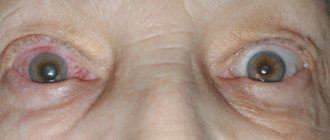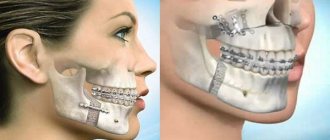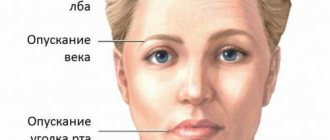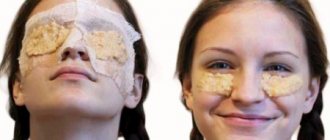Eye asymmetry is characterized by the fact that the tissues of the upper eyelid hang heavily over the lower eyelid, and this leads to the fact that the eye becomes partially or completely blocked. The final result is eyes of different sizes, which cannot have a positive effect on one’s appearance and introduces disproportion into the overall appearance.
It so happens that every human body naturally has slight asymmetry, which does not affect external data in any way. But, although in youth such defects cannot be noticed with the naked eye, already in adulthood they can lead to illness and become noticeable due to the fact that the skin begins to sag.
Many people face a problem such as asymmetry, but the reasons that lead to the disease are different for each person. We will talk about them below, and also talk about how to deal with eye asymmetry.
What are the main causes of eye asymmetry?
The problem of ocular asymmetry can be either congenital or acquired. In order not to start the disease and begin treatment immediately, it is necessary to understand what symptoms indicate a congenital disease. Among these reasons are the following:
- the jaw apparatus was formed incorrectly during intrauterine development or immediately after birth;
- the structure of the skull was also formed incorrectly;
- the lower jaw is underdeveloped;
- abnormalities develop in muscle tissue;
- A pathology of the cervical vertebra is formed, but only on one (left or right) side of the body.
But eye asymmetry can lead to an acquired disease:
- untreated strabismus, especially if this disease is pronounced;
- if one side of the jaw does not have many teeth;
- inflammation or injury to the facial nerve;
- injuries related to the face or jaw dislocation;
- pathologies with bite;
- diseases associated with connective tissue;
- bad habits, such as sleeping on only one side - right or left - or squinting your eyes.
The cause of eye asymmetry is also caused by harmful facial habits, which include constantly winking with only one eye, raising one eyebrow upward. And if you add to this an ineptly performed blepharoplasty or Botox injections, then the changes will be visible to the naked eye.
Homeopathic remedies
The recommendations of a practicing homeopath will help treat eye diseases taking into account the constitutional characteristics of a person. At home, with the help of homeopathic medicines, you can quickly get rid of the unpleasant manifestations of ailments.
| Symptoms | Drugs |
| Pain due to neuritis of the facial nerve, reduction in the incision of the eye. | |
| Inflammation of a traumatic nature, swelling of the eyelids. | |
| Allergic conjunctivitis, lacrimation, swelling of the eyes. | |
| Conjunctivitis resulting from injury; redness of the sclera, purulent discharge from the eyes. | |
| Foreign body in the eye, burn, burning pain. |
Nature is an amazing mechanism that strives to constantly maintain balance and harmony throughout the world. Destructive elements are replaced by gentle natural phenomena. Taking a closer look at many natural phenomena and bodies, you will understand that symmetry and geometric clarity of line are not characteristic of nature. A similar situation exists with the human body.
Why is one eye larger than the other?
The answer to this question should be approached from a medical point of view. The fact is that eye diseases are accompanied by various symptoms, in particular redness of the mucous membrane, burning sensation or purulent discharge. Often the symptom is a visual change in the position of the eyes. If you have inflammation, you may have one eye higher than the other. It is very difficult to diagnose the disease, especially for an unqualified doctor, so it is better to resort to traditional methods of treatment. The most common eye disease is conjunctivitis. It can appear due to injury, exposure to a virus or bacterial infection. Each reason requires its own individual medical approach. If one eye is larger than the other and the mucous membrane is not infected, then it is difficult for the ophthalmologist to diagnose the cause and type of the disease. In such cases, the patient needs the help of a neurologist.
Why does a child have different sized eyes?
If this symptom is detected, parents should contact an ophthalmologist. If your doctor cannot diagnose the reason why one eye is larger than the other, you should visit an orthopedic surgeon. You should not be surprised, since all organs are interconnected. With the development of scoliotic disease, the child's spine will begin to curve, which can lead to a curvature of the neck. Improper development of the muscles and nerve endings of the neck disrupts the integrity of the facial muscles. If you notice that your child’s pupils have changed in diameter, you should consult a neurologist. These symptoms indicate that the baby may develop vascular pathology or a failure in cerebral circulation. After the examination, the child will be prescribed a procedure to measure intraocular pressure and examine the fundus, which will be performed by an ophthalmologist.
Neurological diseases
If you or your loved one has one eye larger than the other and the following symptoms are present: difficulty pronouncing words, paralysis of the facial muscles, then this is a serious reason to visit a neurologist. With such symptoms, a variety of diseases can appear: from circulatory disorders in the medulla oblongata to malignant sarcoma.
Inflammation of the facial nerve
If one eye is larger than the other and is accompanied by numerous swelling, then this may indicate the development of inflammation of the facial nerve. The cause of an inflamed nerve can be purulent formations in the jaw or hypothermia. It should be remembered that when treating neurological diseases, one should adhere to drug treatment rather than physiological treatment. Otherwise, the facial deformity may remain on your face for a long time. In advanced cases, it will remain forever.
However, eye asymmetry is not always so harmless. In some cases, it may indicate ophthalmological and neurological diseases. Sudden, pronounced asymmetry is extremely dangerous, so if it appears, you should consult a doctor.
In this article we will find out why one eye becomes larger or smaller than the other and figure out what to do in this case.
Ocular asymmetry and blephoplasty
Blephoplasty is necessary when the usual treatment with exercises and creams can no longer help, and the disadvantages of the disease, such as drooping eye skin over the eyelid, are visible. This method will help correct the situation even when the asymmetry is in a very severe and advanced stage.
Surgery helps remove areas of excess skin. Excess tissue can be excised either in the center or corners, or throughout the entire area (width). The result is the same - to create a beautiful, even and symmetrical eyelid.
Rehabilitation proceeds in the same way as recovery after classic eyelid surgery, namely:
- after 7-10 days the swelling that occurs during surgery disappears;
- It takes up to 2-3 weeks for the bruises to disappear;
- for a month the patient should sleep only on his back; any other position is unacceptable during this period, but it is worth considering that the upper body should be raised;
- if the doctor prescribes, then it is necessary to do physiotherapeutic procedures and compresses daily;
- Do not use makeup until the seams are completely closed;
- It takes 2-3 months for the patient to see the final result he was striving for.
Symptoms of pathology
As a rule, with facial asymmetry, the problem is externally manifested in the fact that the right side is wider than the left. If a citizen has natural asymmetry, then the discrepancy in size between the sides can be completely insignificant in the form of 2-3 mm. This appears as a slight deformation. The patient's disturbances are expressed as follows:
- the damaged half of the face is characterized by weakness of the facial muscles and takes on the appearance of a mask;
- folds in the forehead, nose and lips are less noticeable;
- the palpebral fissure widens significantly;
- at the mouth the corners change direction (directed downwards);
- the damaged area gives the face a distressed appearance;
- the facial muscles lose their mobility, and the patient can no longer close his eyes normally or wrinkle his forehead;
- a sick person speaks poorly and cannot eat normally because it simply falls out of the mouth;
- Painful sensations often appear in the damaged area.
In children, the disorder appears when the child lies on only one side for a long time. As a rule, the face takes on a flat shape in the cheek area, and the head tilts to the injured side.
In what cases will blephoplasty not help?
Many patients are unable to distinguish blepharoptosis from eye asymmetry. Blepharoptosis is insidious in that the nerves of the oculomotor system are affected; the symptoms of this disease are similar to asymmetry - the palpebral fissure narrows, and the eyelid droops.
Pathology has three stages:
- ⅓ of the pupil is blocked by the eyelid;
- the pupil is half closed;
- the eye pupil closes 100%.
Blepharoptosis is a disease that can be congenital or affect people, regardless of their age. The pathology is accompanied by such manifestations as partial loss of vision and irritability of the mucous membrane. If there are such problems, then even surgical intervention will not be able to restore the symmetry of the eyes.
Prevention of childhood astigmatism
The acquired form of the disease is easier to prevent by following simple rules:
- ensure proper lighting in the house, especially in the nursery;
- alternate physical and visual activity;
- teach and perform eye exercises with children;
- massage the eyelids;
- eat a balanced diet (paying attention to a sufficient amount of vitamin A);
- protect eyes from injury and infection;
- Have an annual checkup with an ophthalmologist.
Might also be useful:
- Laser correction of astigmatism
- Laser vision correction
- Vision diagnostics
Treatment of blepharoptosis
Only a professional ophthalmologist with experience after examination and special studies will be able to make the correct diagnosis. But in this case, a consultation with a neurologist will not be superfluous. If the asymmetry of the eye is mild, in the initial stage, then it can be corrected with the help of physiotherapy and drug treatment. Severe cases require surgery.
Also, after surgery to return the drooping eye to its natural position, in some cases blepharoplasty is recommended - it will help hide cosmetic defects.
Photo source: Internet
How is the disease diagnosed?
To begin treating the pathology, it is necessary to conduct a diagnosis and make an accurate diagnosis. As a rule, to identify an illness, the doctor first visually examines the patient’s face for the presence of pathologies of muscles, teeth or nerve endings. After a visual examination, the specialist talks with the patient regarding hereditary pathologies, as well as the presence of serious injuries.
At the next stage, it is necessary, using a measuring device, to determine the proportions of the face and identify damage or deformation. The pathological disorder starts from 3 mm or 5 degrees. To definitively check for the presence of asymmetry, a drawing of the patient's face is performed using two right or left sides. The result is two identical images, which may have striking differences from the patient's face.
Main symptoms
The symptoms of strabismus are associated not only with external manifestations that are immediately visible. It is also accompanied by internal disorders caused by pathologies of the visual organ. Why does strabismus develop in adults:
- related predisposition (genetic cause);
- various injuries, brain diseases;
- mental trauma (as a rule, this is severe fear);
- eye diseases resulting in loss of vision or blindness in one eye (cataracts, retinal detachment);
- difference in refraction of the eyes;
- farsightedness, myopia;
- infectious diseases (measles, influenza, scarlet fever);
- paresis of the oculomotor nerve;
- stress.
Visual signs of strabismus that are detected even before visiting a specialist:
- involuntary movement of the eye towards the bridge of the nose or temple;
- asynchronous movement of the eyeballs;
- double vision;
- increased squinting;
- tilting and turning the head to look at objects.
The main symptoms are often accompanied by additional ones of an internal nature:
- often disturbing headache;
- dizziness;
- noticeable decrease in visual acuity;
- ailments such as vestibular disorders, nausea, vomiting;
- decreased concentration and memory loss.
If any of the listed signs of strabismus are detected in yourself or your loved ones, an urgent consultation with an ophthalmologist is necessary. Delayed treatment or lack of adequate treatment at all will lead to progression of the disease, which may result in blindness of the squinting eye.










